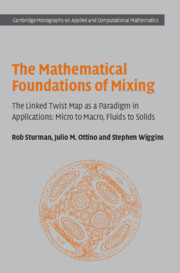 The Mathematical Foundations of Mixing
The Mathematical Foundations of Mixing Book contents
- Frontmatter
- Contents
- Preface
- Acknowledgments
- 1 Mixing: physical issues
- 2 Linked twist maps: definition, construction and the relevance to mixing
- 3 The ergodic hierarchy
- 4 Existence of a horseshoe for the linked twist map
- 5 Hyperbolicity
- 6 The ergodic partition for toral linked twist maps
- 7 Ergodicity and the Bernoulli property for toral linked twist maps
- 8 Linked twist maps on the plane
- 9 Further directions and open problems
- References
- Index
2 - Linked twist maps: definition, construction and the relevance to mixing
Published online by Cambridge University Press: 03 February 2010
- Frontmatter
- Contents
- Preface
- Acknowledgments
- 1 Mixing: physical issues
- 2 Linked twist maps: definition, construction and the relevance to mixing
- 3 The ergodic hierarchy
- 4 Existence of a horseshoe for the linked twist map
- 5 Hyperbolicity
- 6 The ergodic partition for toral linked twist maps
- 7 Ergodicity and the Bernoulli property for toral linked twist maps
- 8 Linked twist maps on the plane
- 9 Further directions and open problems
- References
- Index
Summary
In this chapter we give formal definitions of linked twist maps on the plane and linked twist maps on the torus. We give heuristic descriptions of the mechanisms that give rise to good mixing for linked twist maps, and highlight the role played by ‘co-rotation’ and ‘counter-rotation’. We show how to construct linked twist maps from blinking flows and from duct flows, and we describe a number of additional examples of mixers that can be treated within the linked twist map framework.
Introduction
The central theme of this book is that the mathematical notion of a linked twist map, and attendant dynamical consequences, is naturally present in a variety of different mixing situations. In this chapter we will define what we mean by a linked twist map, and then give a general idea of why they capture the essence of ‘good mixing’. To do this we will first describe the notion of a linked twist map as first studied in the mathematical literature. This setting may at first appear to have little to do with the types of situations arising in fluid mechanics, but we will argue the contrary later. However, this more mathematically ideal setting allows one to rigorously prove strong mixing properties in a rather direct fashion that would likely be impossible for the types of maps arising in typical fluid mechanical situations. We will then consider a variety of mixers and mixing situations and show how the linked twist map structure naturally arises.
- Type
- Chapter
- Information
- The Mathematical Foundations of MixingThe Linked Twist Map as a Paradigm in Applications: Micro to Macro, Fluids to Solids, pp. 31 - 58Publisher: Cambridge University PressPrint publication year: 2006


